Four
FORMATION AND GROWTH OF ROCKY MOUNTAIN NATIONAL PARK
In 1907 and 1908, various regional plans were being discussed to address such topics as wildlife protection in the magnificent mountainous area that is now Rocky Mountain National Park. Some proposed the area be turned into a game refuge. But others, led by Enos Mills, thought in much larger terms. They wanted far more protection than a game park provided or than was available by designation as a national forest. Mills and other like-minded conservationists wanted to establish a national park. Mills’s original plan for such a park called for 1,000 square miles of land with Estes Park in the center. Such a plan led to vehement opposition by many groups and individuals, including H. N. Wheeler of the forest service.
Mills continued his efforts to create a park. Thanks to compromise bills reducing the area of land, which were drawn up by James Grafton Rogers and which made the park plan more palatable, Congress finally passed a bill creating the park that was signed by Pres. Woodrow Wilson in 1915. Creation of luxury spots like the Stanley Hotel brought many new visitors. This number greatly increased with the improvement of local roads and the construction of Trail Ridge Road through the park.
The number of park facilities and personnel expanded yearly to meet the needs of a growing public. In 1929, the Never Summer Range was added to the park. Today Rocky Mountain National Park hosts more than three million visitors a year. It is accessible by three roads, encompasses 265,770 acres, contains five drive-in campgrounds and 369 miles of trails, and has over 60 named peaks that are higher than 12,000 feet. The mission of the park service is to “preserve this natural treasure unimpaired for the enjoyment of this and future generations.”
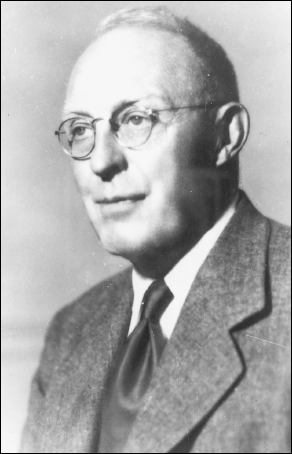
James Grafton Rogers, a Denver attorney, assisted Enos Mills when opposition arose over the formation of a park. Mills envisioned a “Mountain Climbing Organization” whose objective was to create Rocky Mountain National Park. The Colorado Mountain Club resulted from this effort and held its first meeting in April 1912. Rogers went on to draft park bills sent to Congress over the next three years.
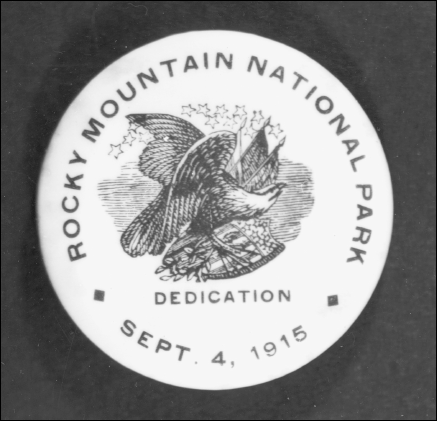
Since Enos Mills’s original proposal was opposed by local and mining interests, changes were necessary if a park bill was to make it through Congress. James Grafton Rogers drafted compromise legislation that angered Mills. The new bill finally passed Congress and was signed by Pres. Woodrow Wilson on January 26, 1915. The formal dedication ceremony, commemorated by this seal, was held on September 4, 1915, at Horseshoe Park.
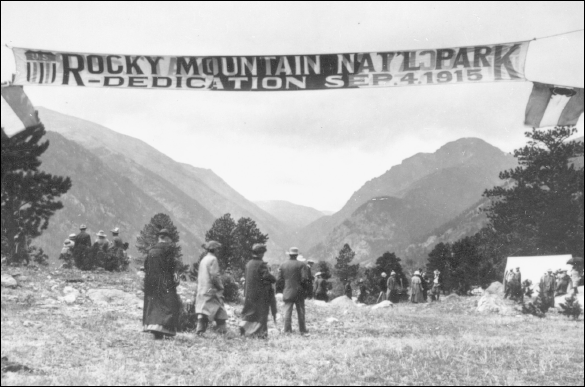
As Enos Mills opened the ceremonies to dedicate the newly formed Rocky Mountain National Park, rain began to fall, but rain could not dampen the enthusiasm generated by the event, which was proclaimed by proud banners. An estimated 2,000 people attended the dedication. Many came on foot, on horseback, and in carriages. As the ceremonies continued, the rain stopped, clouds parted, the sun shone, and Longs Peak came into view.
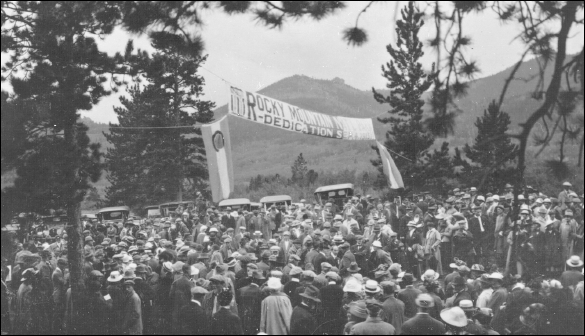
Nearby cities announced the time and place of the dedication ceremonies in their newspapers and fanned a friendly rivalry among cities by encouraging people who drove to Horseshoe Park to display the names of their communities on banners affixed to their automobiles. Some said it was the largest gathering of automobiles yet in the state of Colorado.

Many distinguished guests attended the colorful park dedication ceremonies held in 1915, including Stephen Mather, associate Secretary of the Interior, who was soon to become the first director of the National Park Service. With Mather in this picture are Gov. George Carlson, Abner Sprague, and representatives of the Este’s Park Women’s Club.
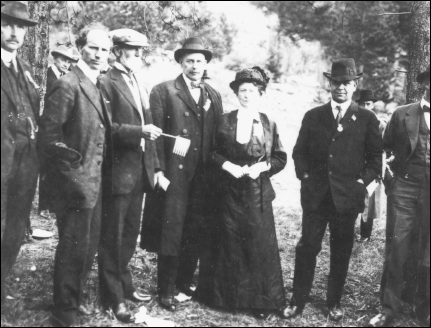
Among those pictured here at the Rocky Mountain National Park dedication ceremony are Enos Mills (no hat), who had campaigned so long and hard for this park. Standing immediately to the left of Mills and holding a small flag is F. O. Stanley, a staunch supporter of the park who was a wealthy inventor and the owner of the Stanley Hotel in Estes Park.
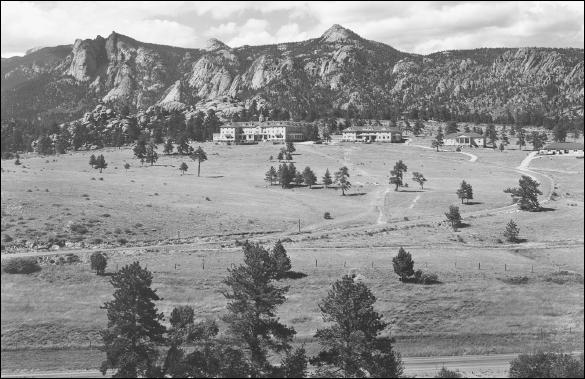
For health reasons, Freelan Oscar Stanley moved to Estes Park, where he and his wife, Flora, lived in a rented cabin. In 1906, they built a home on Wonder View Avenue. Stanley purchased 1,400 acres of land from the Earl of Dunraven and began planning a luxury hotel. Believing that magnificent scenery would attract guests from the East Coast, Stanley began work on the hotel, which was completed in 1909.
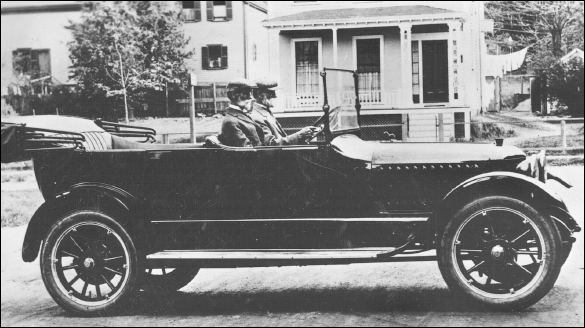
Freelan Oscar Stanley and his twin brother, Francis, are shown in this 1917 photograph driving one of their famous Stanley Steamer automobiles. The brothers made their fortune first by developing and selling a successful dry-plate photography business, and then by designing an early car with a steam engine. After selling their original design, they designed a new and improved car marketed under the name Stanley Steamer.
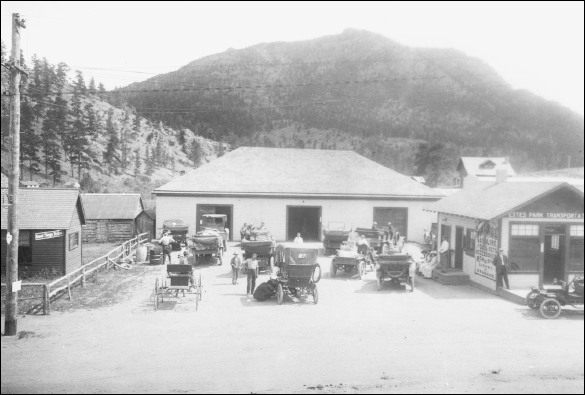
Guests came to the Stanley Hotel from Denver in a fleet of Stanley Steamer automobiles. Over the next 10 years, Stanley kept busy with many projects to improve the town of Estes Park. He built a hydroelectric plant, gave land for a fairgrounds and city park, and improved roads. Carriages and Stanley Steamer automobiles comingle in this 1912 photograph taken in Estes Park.
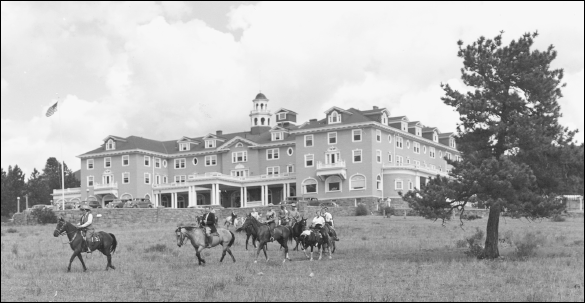
The Stanley Hotel boasted a first-class kitchen, an elegant billiard room, and a music room that featured of view of Longs Peak out the window. There were tennis courts and an 18-hole golf course. A horseback party takes advantage of the extensive grounds at the Stanley Hotel in this picture taken by George A. Grant in 1938.

This 1965 photograph taken by park ranger Pat Miller shows the construction of the new park headquarters and visitor center at Beaver Meadows. In addition to this headquarters complex, the park also contains the Kawuneechee Visitor Center, the Alpine Visitor Center, the Lily Lake Visitor Center, and the Moraine Park Museum. In addition, there are information kiosks and seasonal information stations.
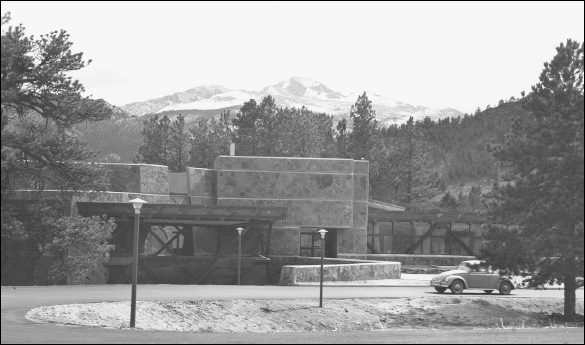
This 1967 photograph taken by naturalist Wayne B. Alcorn shows the completed headquarters building and Beaver Meadows Visitor Center. Designed by the Frank Lloyd Wright School of Architecture at Taliesin West in Scottsdale, Arizona, it is a National Historical Landmark. In the background is majestic Longs Peak, the highest mountain in the park standing at 14,259 feet.
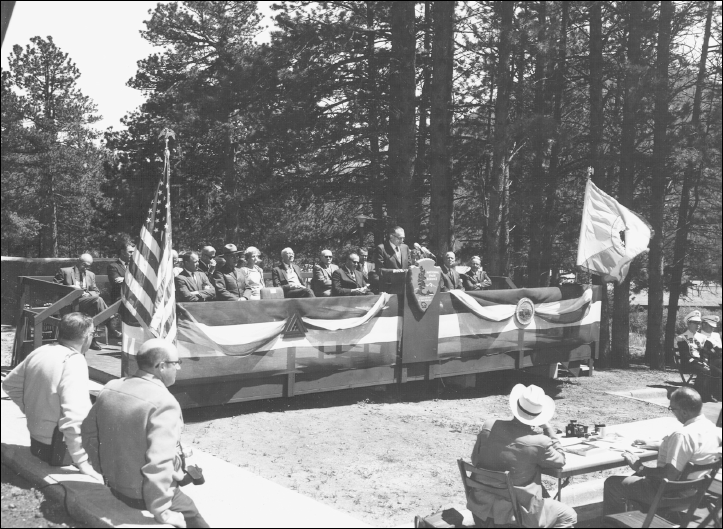
The dedication ceremony for the new Rocky Mountain National Park Headquarters at Beaver Meadows took place on June 24, 1967, and was captured in this photograph by park naturalist Wayne B. Alcorn. The design for this building incorporated the park’s popular rustic style, integrating the buildings into their natural setting. The surrounding utility buildings are examples of the rustic-style buildings that the Civilian Conservation Corps built during the Depression. Rocky Mountain National Park has grown from its 1915 beginnings with the additional land of the Never Summer Range and through building and improving roads and facilities like the new park headquarters. In 1914, an estimated 56,000 people visited the region. By 2002, there were 3.3 million visitors, and this number grows each year. Expansion of park services continues today as the park looks forward to its 100th anniversary in 2015.